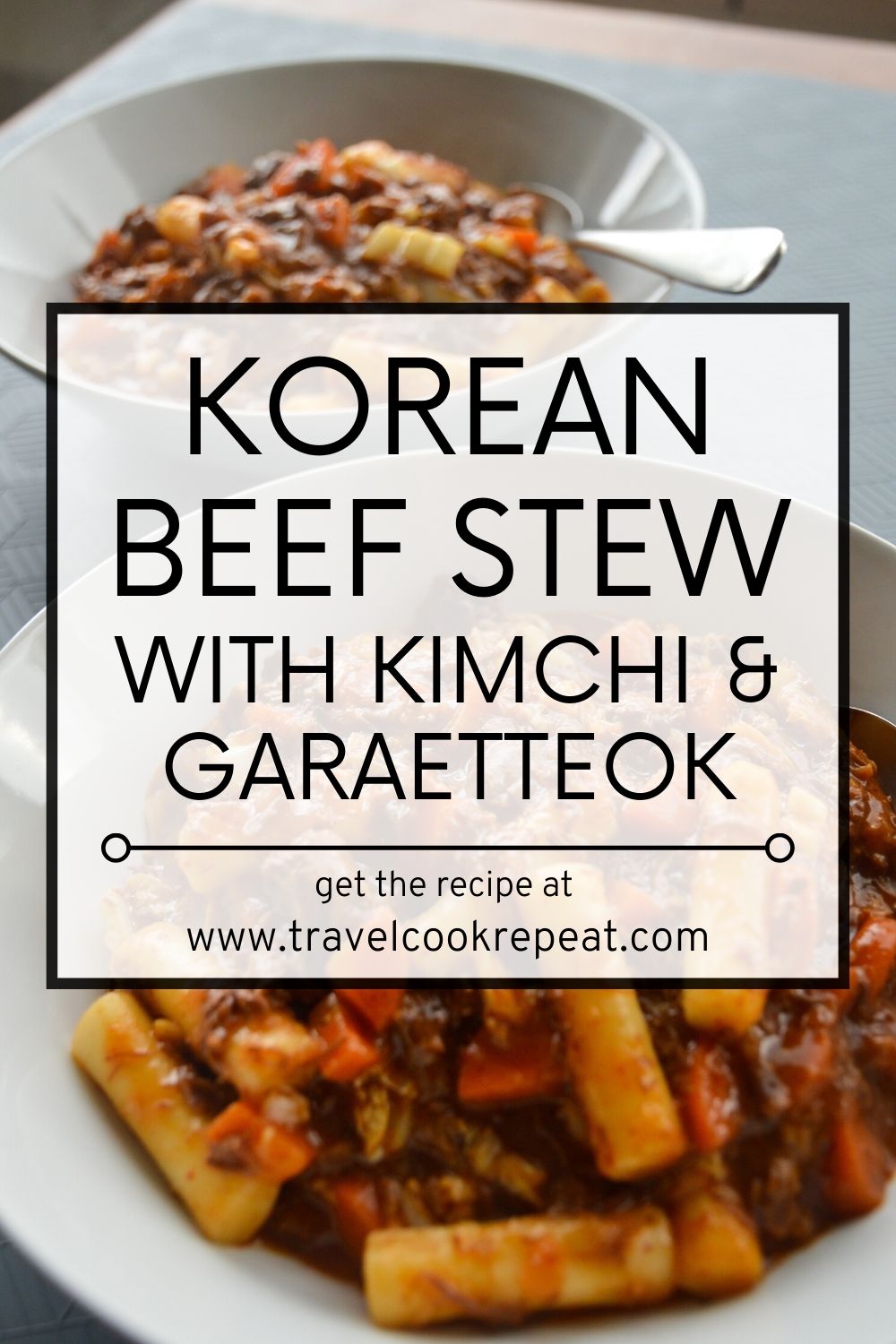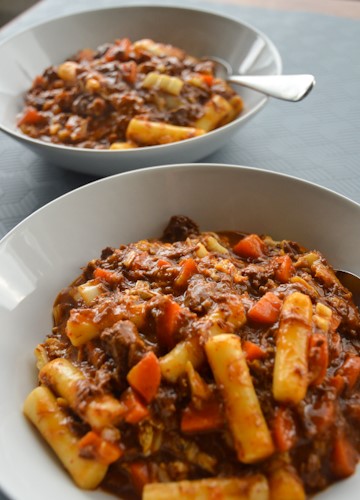Spice up your stew game with our Korean beef stew recipe. With Korean ingredients like gochujang, doenjang, and garaetteok (Korean rice cakes), we put a unique spin on a classic comfort food.
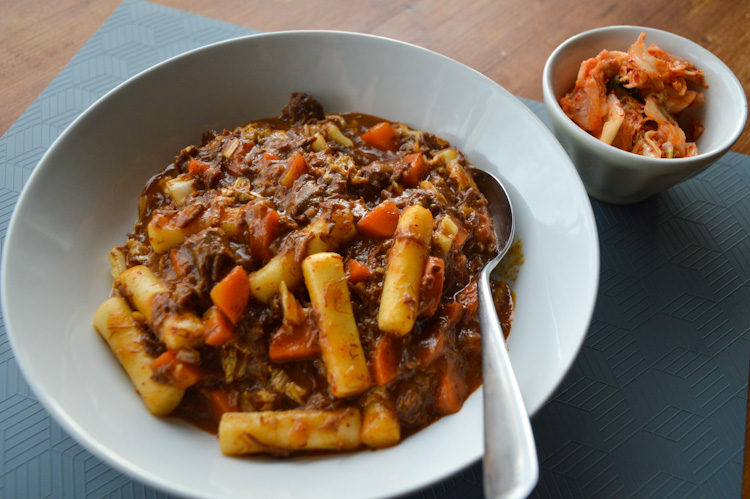
This Korean beef stew was inspired by the Korean ingredients that have become staples in our kitchen, our love of hearty stew during the colder months, and a desire to try something new in terms of stew starch.
Let’s take them one at a time, shall we?
Ingredients
This is a Korean stew because its key, most flavorful ingredients are Korean.
We spice the stew up with Korean chili flake and gochujang, the sweet (and spicy) red pepper paste we love so much. Korean red chili flake has a smoky flavor and a mild level of heat. If you don’t have it you could substitute Aleppo chili flake or powder.
We umami the stew up with beef, of course, but also doenjang which is a fermented soy bean paste. It is similar to Japanese miso paste, and you could (and we have done so ourselves) use that as a subsititute. However, while miso paste is vegan, doenjang has fish paste, which makes it a bit more rich and salty and funky.
We serve it with kimchi – either on the side or atop, whichever your preference.
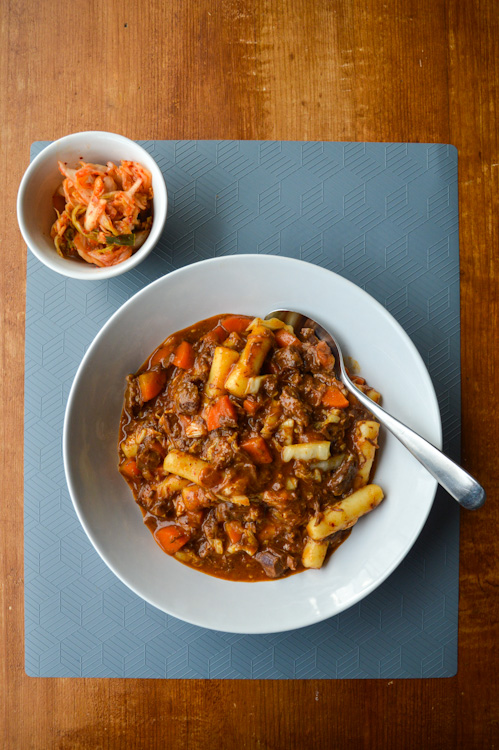
However, the most genius of the ingredients in our Korean beef stew is the starch: garaetteok.
Describing garaetteok is odd. They are, according to the package, “rice cakes tubular type”. They are, according to Wikipedia, “cylindrical rice cakes made of non-glutinous rice”. These descriptions are either not descriptive in any way, or tell you everything you could ever want to know (we’re still not sure). They are a clever (if we do say so) carb base where potatoes or rice would (and still could!) do.
They are even more perfect because when you cook them in the stew (as we will describe below), they leech some of their starchiness and therefore thicken the stew a bit. They are also chewy, which (we now know) is a pleasing effect in stew.
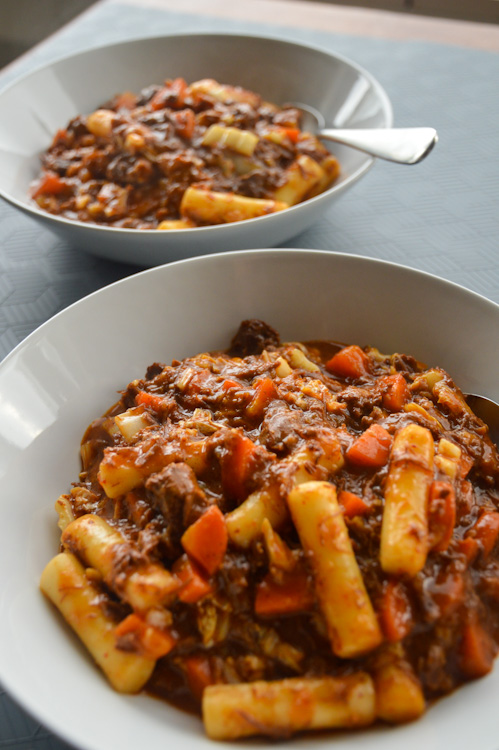
Please note, any shape of non-glutenous rice cake will do. We’re just partial to the tubular type. However, if you do use a different shaped/sized cake, you may want to adjust the cooking time accordingly.
The rest of the ingredients, which you can read in detail in the recipe card below, are pretty standard stew fare.
Recipe tips
This Korean stew is made pretty much like any other beef stew, with a few twists. We’ll detail those here, but of course follow all the steps in the recipe card below.
Tip 1: marinate the beef. We borrowed this approach from our stoofvlees (Flemish beef stew). The marinade is simple – Korean chili flake, salt, and rice wine vinegar. It both tenderizes the meat and imbues it with even more flavor.
Tip 2: cook the carrots twice. We love carrots in stew – they add a sweet, earthiness that you can’t get anywhere else. But we don’t love carrots that have been cooking in stew for hours because then all their flavor is gone and they are just mushy pieces of orange. To solve this problem we’ve taken to cooking our carrots twice.
First, sauté the carrots – along with some fresh ginger – in some oil for a few minutes. This step drags some extra goodness out of the carrots so they’re super flavorful. Then, about a half hour before the stew is done, add the carrots and ginger into the stew. This ensures you get the flavor punch from both ingredients, and the carrots still retain some of their texture.
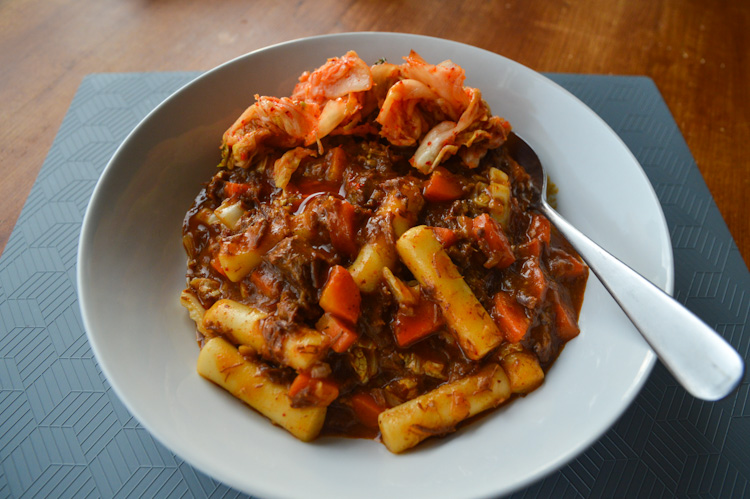
Tip 3: add gochujang in batches. We add most of the gochujang at the beginning stages, so it can cook into the stew for several hours. But we love gochujang so much, we also add a bit towards the end to ensure a bit of heat, tang, and sweet that it brings shines through.
Tip 4: check and stir the stew every 30-45 minutes to help it not stick to the bottom of the pot. If your stew happens to stick to the bottom of the pot during the process of cooking it, don’t fret. It happens to the best of us, and ultimately means more flavor. 30-45 minutes isn’t enough time to do too much harm or blacken things too terribly. Just add a little water and scrape it all up.
Tip 5: soak the garaetteok in warm water for ~10 minutes before putting in the stew. This will loosen them up a bit and make them more receptive to all the delicious stew flavors.
Tip 6: serve with your favorite kimchi (ours is Jongga brand, about which we waxed poetic in our gochujang fried rice recipe).
Eet smakelijk!
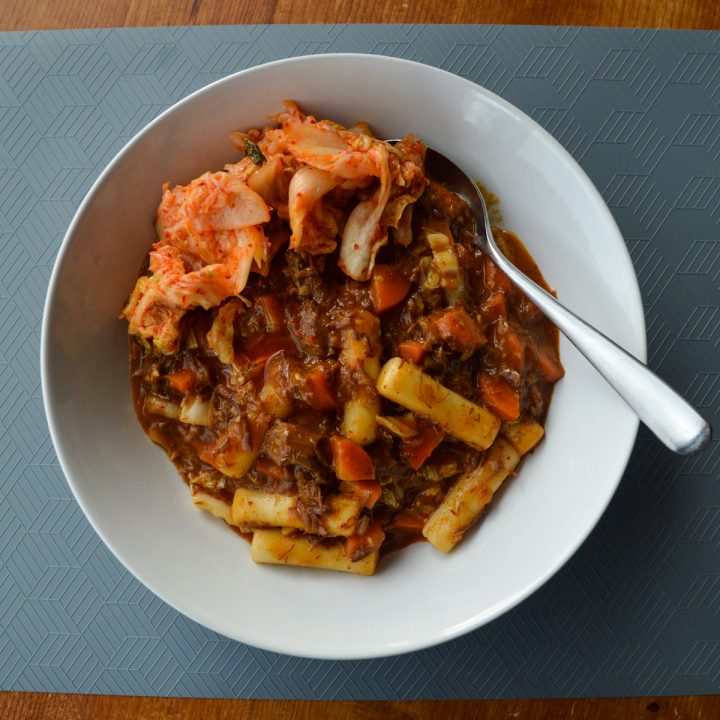
Korean Beef Stew
Korean beef stew is exactly what you need on those cold nights when you want something rich and warming. We combined some of our favorite ingredients and added Korean rice cakes (garaetteok) to bring Korean flavor to a hearty beef stew. Try spicing up your stew game with this unique recipe.
Ingredients
- 1 lb beef, cut into 1-inch cubes
- 1/8 tsp salt, plus 2 pinches, divided
- 1 tsp Korean red chili flake
- 1/2 tsp plus 1/8 cup rice wine vinegar, divided
- 2 1/2 tsp neutral cooking oil, divided
- 1 carrot, chopped into half moons
- 1 tsp ginger, minced
- 1 medium onion, diced
- 2 cloves garlic, minced
- 1/2 cup white wine
- 2 cups beef stock
- 2 Tbsp plus 1 tsp gochujang, divided
- 1 Tbsp doenjang (see notes for red miso paste substitution)
- 1 tsp white sugar
- 2 bay leaves
- 1 tsp toasted sesame oil
- 1/2 lb garaetteok (tubular, non-glutenous rice cakes)
- 1/2 head of green cabbage, cut in bite-sized pieces
- Dash of fish sauce
- Plenty of kimchi
Instructions
- In a small bowl, mix the cubes of beef with 1/8 tsp salt, 1 tsp Korean chili flake, and 1/2 tsp rice wine vinegar. Pop it in the fridge and marinate for at least 1 hour. Take it out of the fridge 10 minutes before you start to cook the stew to take the chill off it.
- Heat a Dutch oven over medium heat. Add 1/2 tsp oil plus the carrots, ginger, and a pinch of salt. Cook for 3 minutes. Remove and set aside.
- Add 1 tsp oil and brown beef. Don't crowd it, so depending on how large your pot is, you may need to do this in 2 batches. Each batch should cook ~4 minutes. Remove and set aside (in a different bowl from the carrots).
- Turn heat down to low. Add another 1 tsp oil, the onions, and another pinch of salt. Cook 2 minutes until soft.
- Add garlic and cook for 30 seconds or so until fragrant. Turn the heat up and deglaze with white wine and 1/8 cup rice wine vinegar.
- Add the beef, beef stock, 3 cups water, 2 Tbsp gochujang, all of the doenjang (or red miso paste), the sugar, and the bay leaves. Bring to a boil, cover, then turn down very low.
- Cook covered for 2 hours. Check and stir the stew every 45 minutes to ensure it's not sticking to the bottom.
- Uncover and cook for another hour. You may need to check it a bit more frequently - every 20-30 minutes or so now.
- Remove the bay leaves. Add in the cooked carrots and ginger, sesame oil, and the last 1 tsp gochujang. Cook uncovered for 20 minutes. At the same time, soak the garaetteok in warm water.
- Add the garaetteok, cabbage, and a dash of fish sauce to the stew. Cook for a final 10 minutes until the rice cakes are cooked through.
- Serve with kimchi atop or astride.
Notes
Substitutions
- Korean red chili flake has a smoky flavor and a mild level of heat. If you don't have you could substitute Aleppo chili flake or powder.
- As mentioned in the ingredients list, if you don't have or can't find doenjang, miso paste is a good substitute. They taste very similar, although doenjang is saltier and a bit funkier since it has fish paste (miso paste is vegetarian). If you're using miso paste, we recommend doubling it to 2 Tbsp.
- Any shape of non-glutenous rice cake will do. We're just partial to the tubular type. But you use a different shape, it may require less cooking time.
Tip
- If your stew happens to stick to the bottom of the pot during the process of cooking it, don't fret. It happens to the best of us, and honestly just means more flavor. Just add a little water and scrape it all up.
